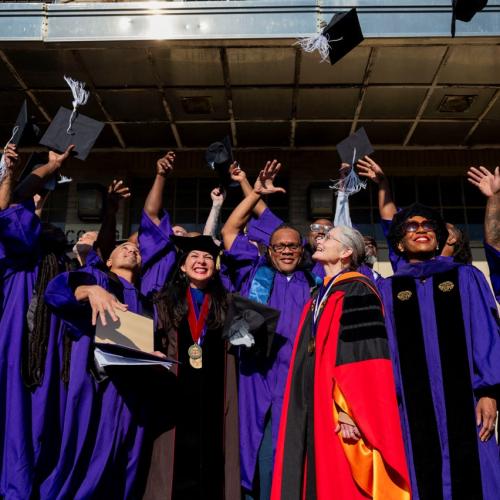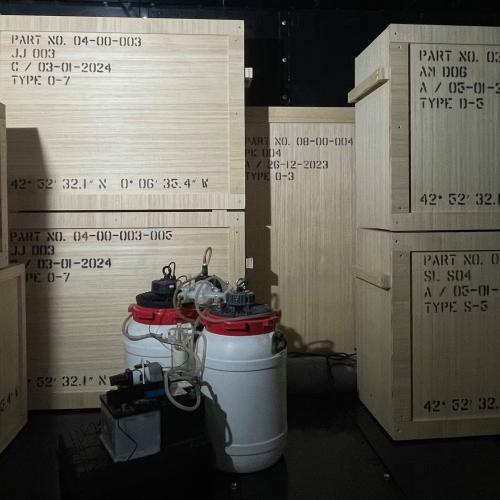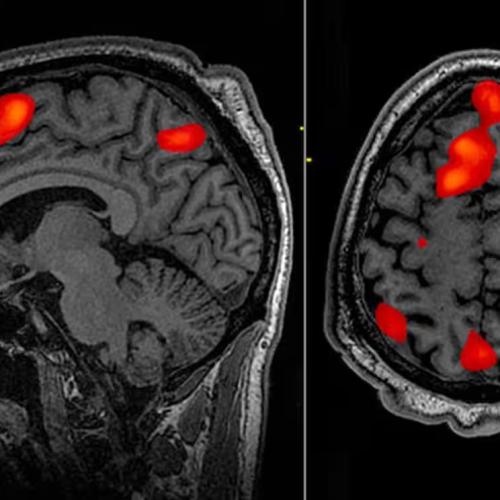Nature of Reality News Stories
Below are key excerpts of revealing news articles on the mysterious nature of reality from reliable news media sources. If any link fails to function, a paywall blocks full access, or the article is no longer available, try these digital tools.
Saturn's orange moon Titan has hundreds of times more liquid hydrocarbons than all the known oil and natural gas reserves on Earth, according to new data from NASA's Cassini spacecraft. The hydrocarbons rain from the sky, collecting in vast deposits that form lakes and dunes. The new findings from the study led by Ralph Lorenz, Cassini radar team member from the Johns Hopkins University Applied Physics Laboratory, Laurel, Md., are reported in ... the Geophysical Research Letters. "Titan is just covered in carbon-bearing material -- it's a giant factory of organic chemicals," said Lorenz. "This vast carbon inventory is an important window into the geology and climate history of Titan." At a balmy minus 179 degrees Celsius (minus 290 degrees Fahrenheit), Titan is a far cry from Earth. Instead of water, liquid hydrocarbons in the form of methane and ethane are present on the moon's surface. Cassini has mapped about 20 percent of Titan's surface with radar. Several hundred lakes and seas have been observed, with each of several dozen estimated to contain more hydrocarbon liquid than Earth's oil and gas reserves. Proven reserves of natural gas on Earth total 130 billion tons, enough to provide 300 times the amount of energy the entire United States uses annually for residential heating, cooling and lighting. Dozens of Titan's lakes individually have the equivalent of at least this much energy in the form of methane and ethane.
Note: Weren’t we taught that oil and gas come from fossils? Yet the many who have shown evidence otherwise have been dismissed and ridiculed. Why is this? For more along these lines, see concise summaries of deeply revealing news articles on the mysterious nature of reality from reliable major media sources.
An unknown source has been sending radio blasts towards Earth since at least 1988, scientists say. For 35 years, the source has been sending out regular 20-minute blasts of energy that vary considerably in their brightness, researchers say. The emissions appear something like the blasts that come out of pulsars or fast radio bursts, which last for milliseconds to several seconds. But the newly discovered source sends radio signals that pulsate on a period of 21 minutes – something previously thought impossible by expected explanations. Pulsars are neutron stars that spin around quickly, throwing out radio blasts as they do. When one crosses Earth, the emissions can be picked up very briefly and brightly, like being in the path of the light from a rotating lighthouse. Scientists believe that process can only work if the magnetic field of the pulsar is strong, and it is rotating quickly enough – if not, there would not be enough energy to see the pulsar from Earth. That has led to the development of the “pulsar death line”, which suggests that sources must be spinning fast and strong enough to be detected. The newly discovered object named GPMJ1839-10, however, is way beyond that death line. If it is a pulsar, then it seems to be operating in ways that scientists thought impossible. It could also be a highly magnetised white dwarf or magnetar, an extra kind of neutron star with incredibly strong magnetic fields. But they do not tend to send out emissions of this kind, researchers believe.
Note: For more along these lines, see concise summaries of deeply revealing news articles on the mysterious nature of reality from reliable major media sources.
Plants make popping sounds that are undetectable to the human ear, according to recordings made in a new study — and they make more sounds when thirsty or under other kinds of stress. The research shakes up what most botanists thought they knew about the plant kingdom, which had been considered largely silent, and suggests the world around us is a cacophony of plant sounds, said study coauthor Lilach Hadany. To figure out whether plants actually were emitting sounds, Hadany and her team commissioned soundproofed acoustic boxes. The researchers placed tobacco and tomato plants in the boxes, rigged with ultrasonic microphones that record at frequencies between 20 and 250 kiloherz. (The maximum frequency that a human adult’s ear can detect is about 16 kilohertz.) Some of the plants had cut stems or had not been watered for five days, and others were untouched. The team found that the plants emitted sounds at a frequency of 40 to 80 kilohertz, and when condensed and translated into a frequency humans can hear, the noises were a bit similar to the pop of popcorn being made or bubble wrap bursting. A stressed plant emitted around 30 to 50 of these popping or clicking sounds per hour at seemingly random intervals, but unstressed plants emitted far fewer sounds — around one per hour. “When tomatoes are not stressed at all, they are very quiet,” Hadany said. The researchers don’t know exactly how the sounds are made.
Note: For more along these lines, see concise summaries of deeply revealing news articles on the mysterious nature of reality from reliable major media sources.
The artist, writer and technologist James Bridle begins "Ways of Being" with an uncanny discovery: a line of stakes tagged with unfathomable letters and numbers in thick marker pen. The region of [Greece] is rich in oil, we learn, and the company that won the contract to extract it from the foothills of the Pindus mountains is using "cognitive technologies" to "augment ... strategic decision making." The grid of wooden stakes left by "unmarked vans, helicopters and work crews in hi-vis jackets" are the "tooth- and claw-marks of Artificial Intelligence, at the exact point where it meets the earth." "Ways of Being" sets off on a tour of the natural world, arguing that intelligence is something that "arises ... from thinking and working together," and that "everything is intelligent." We hear of elephants, chimpanzees and dolphins who resist and subvert experiments testing their sense of self. We find redwoods communicating through underground networks. In the most extraordinary result of all, in 2014 the Australian biologist Monica Gagliano showed that mimosa plants can remember a sudden fall for a month. Ever since the Industrial Revolution, science and technology have been used to analyze, conquer and control. But "Ways of Being" argues that they can equally be used to explore and augment connection and empathy. The author cites researchers studying migration patterns with military radar and astronomers turning telescopes designed for surveillance on Earth into instruments for investigating the dark energy of the cosmos.
Note: Read a thought-provoking article featuring a video interview with artist and technologist James Bridle as he explores how technology can be used to reflect the innovative and life-enhancing capacities of non-human natural systems. For more along these lines, see concise summaries of deeply revealing news articles on mysterious nature of reality from reliable major media sources.
One of the more unsettling discoveries in the past half a century is that the universe is not locally real. In this context, “real” means that objects have definite properties independent of observation—an apple can be red even when no one is looking. “Local” means that objects can be influenced only by their surroundings and that any influence cannot travel faster than light. Investigations at the frontiers of quantum physics have found that these things cannot both be true. Instead the evidence shows that objects are not influenced solely by their surroundings, and they may also lack definite properties prior to measurement. Blame for this achievement has now been laid squarely on the shoulders of three physicists: John Clauser, Alain Aspect and Anton Zeilinger. They equally split the 2022 Nobel Prize in Physics “for experiments with entangled photons, establishing the violation of Bell inequalities and pioneering quantum information science.” From about 1940 until as late as 1990, studies of so-called quantum foundations were often treated as philosophy at best and crackpottery at worst. Today quantum information science is among the most vibrant subfields in all of physics. It links Einstein’s general theory of relativity with quantum mechanics. It dictates the design and function of quantum sensors. And it clarifies the often confusing nature of quantum entanglement, a phenomenon that is pivotal to modern materials science and that lies at the heart of quantum computing.
Note: For more along these lines, see concise summaries of deeply revealing news articles on the mysterious nature of reality from reliable major media sources.
Professor John Lorber ... was not jesting totally when he addressed a conference of pediatricians with a paper entitled "Is your brain really necessary?" "There's a young student at this university," says Lorber, "who has an IQ of 126, has gained a first-class honors degree in mathematics, and is socially completely normal. And yet the boy has virtually no brain." The student's physician at the university noticed that the youth had a slightly larger than normal head, and so referred him to Lorber, simply out of interest. "When we did a brain scan on him," Lorber recalls, "we saw that instead of the normal 4.5-centimeter thickness of brain tissue between the ventricles and the cortical surface, there was just a thin layer of mantle measuring a millimeter or so. His cranium is filled mainly with cerebrospinal fluid." Startling as it may seem, this case is nothing new to the medical world. A substantial proportion of patients appear to escape functional impairment in spite of grossly abnormal brain structure. Lorber concludes from these observations that "there must be a tremendous amount of redundancy or spare capacity in the brain, just as there is with kidney and liver." He also contends that "the cortex probably is responsible for a great deal less than most people imagine. For hundreds of years neurologists have assumed that all that is dear to them is performed by the cortex, but it may well be that the deep structures in the brain carry out many of the functions assumed to be the sole province of the cortex."
Note: For more along these lines, see concise summaries of deeply revealing news articles on health and the mysterious nature of reality from reliable major media sources.
Exactly how regular matter first transmuted into the organised self-replicating assemblies of molecules that we call life on Earth is the focus of ongoing scientific research. But a new paper published in the journal Nature Communications strengthens theories that hold the basis of life came from outer space. Using new techniques of chemical analysis, Japanese researchers have now shown all the amino acids necessary to form DNA and RNA, the genetic basis of life can be found in small meteorites that fall to Earth. These “nucleobases” are not examples of extraterrestrial life, but instead the result of chemistry taking place on asteroids while in space, which may then have seeded Earth with the necessary prebiotic material to help the development of life. That material, the study authors write, may have “contributed to the emergence of genetic properties for the earliest life on Earth.” “The absolute abundance of nucleobases of extraterrestrial origin could be enough for further chemical reactions on the early Earth,” said Yasuhiro Oba ... the lead author of the new study. Scientists running simulations of the chemistry taking place on interstellar asteroids seemed to find more evidence supporting the idea that genetic material could form in space, according to Dr Oba. He believes it’s likely the prebiotic chemistry from multiple sources was important to the origins of life — it’s possible terrestrial and extraterrestrial chemistry made their own contributions.
Note: Explore a highly intriguing essay by WTK founder Fred Burks on alien involvement in our world. For more along these lines, see concise summaries of deeply revealing news articles on the mysterious nature of reality from reliable major media sources.
Could our universe have been created in a petri dish? Avi Loeb seems to think so. The Harvard astronomer posits that a higher "class" of civilization may have conjured up our universe in a laboratory far, far away. "Since our universe has a flat geometry with a zero net energy, an advanced civilization could have developed a technology that created a baby universe out of nothing through quantum tunneling," Loeb writes in an op-ed published by Scientific American last year. This theory, he suggests, would unite two seemingly opposite notions: the idea that a higher power might be driving our fate, and the secular concept of quantum gravity (a field of physics that seeks to work gravity into the theory of quantum mechanics–something that, to the bane of physicists everywhere, we haven't been able to do yet on Earth). Primarily, this theory hinges on a far-off advanced civilization's ability to meld both quantum mechanics and gravity and subsequently identify and recreate all of the universe's ingredients. Loeb ... has devised a framework that breaks advanced civilizations down into classes based on their ability to "reproduce the astrophysical conditions that led to its existence." Earthlings would fall into class C because ... we would not be able to recreate our current conditions should the sun suddenly die. A class A civilization, like our proposed creators, would be able to, say, generate large amounts of dark energy and, as Loeb suggests, create "baby universes" ... that could potentially spawn life.
Note: Explore a highly intriguing essay by WTK founder Fred Burks on alien involvement in our world. For more along these lines, see concise summaries of deeply revealing news articles on the mysterious nature of reality from reliable major media sources.
Preliminary results from two experiments suggest something could be wrong with the basic way physicists think the universe works, a prospect that has the field of particle physics both baffled and thrilled. Tiny particles called muons aren’t quite doing what is expected of them in two different long-running experiments in the United States and Europe. The confounding results — if proven right — reveal major problems with the rulebook physicists use to describe and understand how the universe works at the subatomic level. “We think we might be swimming in a sea of background particles all the time that just haven’t been directly discovered,” Fermilab experiment co-chief scientist Chris Polly said. “There might be monsters we haven’t yet imagined that are emerging from the vacuum interacting with our muons and this gives us a window into seeing them.” The rulebook, called the Standard Model, was developed about 50 years ago. The United States Energy Department's Fermilab announced results Wednesday of 8.2 billion races along a track outside Chicago that ... have physicists astir: The muons' magnetic fields don't seem to be what the Standard Model says they should be. This follows new results published last month from the European Center for Nuclear Research's Large Hadron Collider that found a surprising proportion of particles in the aftermath of high-speed collisions. If confirmed, the U.S. results would be the biggest finding in the bizarre world of subatomic particles in nearly 10 years.
Note: For more along these lines, see concise summaries of deeply revealing news articles on the mysterious nature of reality from reliable major media sources.
Findings, published January 12 in the journal Nature, radically change our understanding of evolution and could one day help researchers breed better crops or even help humans fight cancer. Mutations occur when DNA is damaged and left unrepaired, creating a new variation. The scientists wanted to know if mutation was purely random or something deeper. What they found was unexpected. "We always thought of mutation as basically random across the genome," said [paper lead author] Grey Monroe. "It turns out that mutation is very non-random and it's non-random in a way that benefits the plant. It's a totally new way of thinking about mutation." Researchers spent three years sequencing the DNA of hundreds of Arabidopsis thaliana, or thale cress. Sequencing of those ... plants revealed more than 1 million mutations. Within those mutations a nonrandom pattern was revealed, counter to what was expected. Instead of randomness they found patches of the genome with low mutation rates. In those patches, they were surprised to discover an over-representation of essential genes, such as those involved in cell growth and gene expression. "These are the really important regions of the genome," Monroe said. "The areas that are the most biologically important are the ones being protected from mutation." The areas are also sensitive to the harmful effects of new mutations. The findings [reveal] that the plant has evolved to protect its genes from mutation to ensure survival.
Note: For more along these lines, see concise summaries of deeply revealing news articles on the mysterious nature of reality from reliable major media sources.
Researchers taught male mice to fear the smell of cherry blossoms by associating the scent with mild foot shocks. Two weeks later, they bred with females. The resulting pups were raised to adulthood having never been exposed to the smell. Yet when the critters caught a whiff of it for the first time, they suddenly became anxious and fearful. They were even born with more cherry-blossom-detecting neurons in their noses and more brain space devoted to cherry-blossom-smelling. The memory transmission extended out another generation when these male mice bred. Neuroscientists at Emory University found that genetic markers, thought to be wiped clean before birth, were used to transmit a single traumatic experience across generations, leaving behind traces in the behavior and anatomy of future pups. The study, published ... in the journal Nature Neuroscience, adds to a growing pile of evidence suggesting that characteristics outside of the strict genetic code may also be acquired from our parents through epigenetic inheritance. Epigenetics studies how molecules act as DNA markers that influence how the genome is read. We pick up these epigenetic markers during our lives and in various locations on our body as we develop and interact with our environment. The researchers also artificially inseminated females using the sperm from the original fear-conditioned mice. The results were the same, suggesting epigenetic inheritance rather than environment.
Note: The emerging field of epigenetics implies that lifestyle and environment influence the expression of DNA. For more along these lines, see concise summaries of deeply revealing news articles on health from reliable major media sources.
South-west England is the world capital of crop circles. They are particularly concentrated in the county of Wiltshire, where a treasure trove of ancient history includes the Neolithic sites of Stonehenge and Avebury – both crop circle hotspots. Reports of mysterious patterns appearing in wheat, barley and corn fields in the area began to circulate in the 1970s, but it was in the late '80s that the phenomenon exploded. Circles began to appear more frequently and became far more ornate: some resembled trippy fractals; others rune-like hieroglyphs; others stylised animals recalling those of the Nazca Lines in Peru. The intricacy and size of the formations, coupled with the fact that they would appear overnight, seemingly out of nowhere, baffled locals and farmers alike. In 1996, a crop circle appeared opposite Stonehenge depicting a mathematical fractal called a Julia set; a similar formation that emerged on Milk Hill in 2001 was one of the largest ever, stretching 900ft. A 2008 formation near the Iron Age hill fort of Barbury Castle required decoding by an astrophysicist, who concluded that it was a geometric representation of the first 10 digits of pi. The phenomenon peaked in the 1990s and early 2000s, but continues today; an average of 30 crop circles appear each year in the UK, around 80% of them in Wiltshire. Formations reported in 2021 have included a hexagonal pattern overlaid with spirals in Avebury, and a pattern of concentric "bubbles" in Tidworth Down.
Note: For more along these lines, see concise summaries of deeply revealing news articles on the mysterious nature of reality from reliable major media sources.
Laura Beloff's plant seemed to be clicking. She had rigged its roots up to a contact microphone in order to detect faint, high-pitched clicks in the soil. With the help of software she had written for her computer, the frequency of the clicks had been lowered, making them audible to humans. Beloff first had the idea of listening to her plants' roots after reading about experiments by Monica Gagliano. Over the last decade or so, Gagliano, at the University of Western Australia, has published a series of papers that suggest plants have an ability to communicate, learn and remember. She has long argued that scientists should pay greater attention to the fact that plants can transmit and retrieve information acoustically. In a 2017 study, Gagliano and colleagues showed that plants appear to be able to sense the sound of water vibrating via their roots, which may help them to locate it underground. And Gagliano has also raised eyebrows with claims that, in non-experimental settings, she has heard plants speak to her using words. She says that this experience is "outside the strictly scientific realm" and that a third-party observer would not be able to measure the sounds she heard with laboratory instruments. But she is quite certain that she has perceived plants speaking to her on multiple occasions. "I have been in situations where not just me but several others in the same space heard the same thing," she says. But the precise mechanisms through which plants might perceive or sense sound remain mysterious.
Note: Explore a treasure trove of concise summaries of incredibly inspiring news articles which will inspire you to make a difference.
In late February, I walked into a Bigfoot trap in Siskiyou National Forest a few miles north of the California border with Oregon. Posing for a photo inside pretending to be an oversized cryptid, I raised my own overly large foot for effect. A year ago I moved to Arcata — a veritable epicenter of Sasquatch sightings — where Bigfoot-themed businesses, adornments and paraphernalia are commonplace and undoubtedly a tourist draw and economic boon to the area. A scrap metal Bigfoot sculpture stands on a walking path in my town. The sheer concept of Bigfoot is fascinating, which is why I hiked to that trap, and why, when a friend recently mentioned an “Intro to Bigfoot Studies” online class with an instructor from Humboldt State University’s Osher Lifelong Learning Institute, that seemed like fun. Here’s something not fun: having to question your own grip on reality. And actually, that’s part of why some people have a tough time acknowledging the possibility Bigfoot could be real, according to course instructor Steven Saint Thomas. “It's a natural human tendency to want to be comfortable,” Thomas says. “So information that makes you uncomfortable is information you prefer to ignore.” And here’s what many Bigfoot enthusiasts do think proves the existence of the creature: the Patterson-Gimlin film. It was shot by two cowboys near Bluff Creek in 1967, capturing what appears to be a female Bigfoot striding across the forest, turning toward the camera in what has become an iconic stance, and disappearing forever.
Note: Watch the video footage which made bigfoot an international phenomenon on this webpage. For more along these lines, see concise summaries of deeply revealing news articles on the mysterious nature of reality from reliable major media sources.
The "Temple of Man" [is] a five-story underground warren of vast, ornately decorated chambers, with towering pillars, 40-foot-high gold-leaf ceilings, giant frescoes and bronze statues, all linked by narrow passages and concealed stone doors that spring open and shut by electrical command. Begun more than 20 years ago in total secrecy, [the temple] is the spiritual core of Damanhur, a 23-year-old New Age commune nestled ... in the foothills of the Alps. Members [describe] their commune as a nation, one that aims at total self-sufficiency and boasts its own currency, schools, federal and local government, newspapers, Web site and tax code. It has melded California-style New Age spirituality with the customs and mores of northern Italy. It also claims to have its own unique transportation system: time travel. When its 500 full-time residents are not experimenting with time travel and "Selfic" healing, they are industriously churning out luxury items for export. One Damanhur workshop makes Tiffany-style glass products. Another business ... makes silk and cashmere fabrics on 18th-century wooden looms for ... top Italian fashion houses. "We were never hippies," Damanhur's founder, Oberto Airaudi ... explained. "We believed in hard work, personal responsibility and bank loans." Damanhur ... also shares the Italian aversion to ironclad rules and has only one: no smoking. Everything else is pretty much permitted, including long lunches that include wine, pasta and meat, which may help explain why the community has remained intact for more than two decades.
Note: For more on this magical community, see photos of their mind-boggling underground temples and the deeper story of its founding and development on this webpage. Their website is www.damanhur.org.
Ingersoll Lockwood, an American political writer [combined] science fiction and fantasy into his novels from the late 1800s. Two of his most popular works of literature were illustrated children's stories, focusing on a peculiar fictional character: Baron Trump. Trump, an aristocratically wealthy young man living in Castle Trump, is the protagonist of Lockwood's first two fictional novels. The little boy ... is bored of the luxurious lifestyle he has grown so accustomed to. Trump visits Russia to embark on an extraordinary adventure that will shape the rest of his life. There are some incredible connections to be made to the first family of the United States and Lockwood's novels. For starters, the main character's name is the same as President Donald Trump's son, albeit spelt differently. Trump's adventures begin in Russia, and are guided thanks to directions provided by "the master of all masters," a man named "Don." But by Lockwood's third novel, The Last President, things become even more eerily linked to the present day. The story begins with a scene from a panicked New York City in early November, describing a "state of uproar" after the election of an enormously opposed outsider candidate. "Mobs of vast size are organizing under the lead of anarchists and socialists, and threaten to plunder and despoil the houses of the rich who have wronged and oppressed them for so many years. The Fifth Avenue Hotel will be the first to feel the fury of the mob," the novel continues, citing an address in New York City where Trump Tower now stands.
Note: Not mentioned in this article is that Donald Trump's uncle John Trump, was a brilliant MIT scientist whose work involved X-rays and World War II radar research. His NY Times obituary states his work "provided additional years of life to cancer patients throughout the world." A New Yorker article states, "in 1943 the F.B.I. had enough faith in his technical ability and his discretion to call him in when Nikola Tesla died." He has become the subject of strange time travel theories related to Qanon on the Internet that stem from his real-life connection to engineer and inventor Nikola Tesla.
When police found the unconscious man in a Southern California Motel 6, the IDs on him said he was Michael Thomas Boatwright from Florida. But when the man awoke at Desert Regional Medical Center a few days later, he said he'd never heard of Boatwright. He didn't recall serving in the U.S. Navy. Or of being born in Florida. And he didn't speak a word of English. The man said his name was Johan Ek. And he said it in Swedish. Today, the 61-year-old man says he has come to terms with the name "Michael Boatwright," but only because doctors told him he should. He still feels like Johan Ek from Sweden. And he can't explain why. Everything Boatwright knows about his life before February 28 he knows because his social worker [Lisa Hunt-Vasquez] told him or because he read it on websites. He told CNN he learned that in 1987 he operated a consulting company called Kultur Konsult Nykoping. That is somewhat of a Swedish connection. He doesn't have any independent knowledge of his life before he woke up in the hospital. He still feels isolated in the hospital, so Hunt-Vasquez encouraged him to reach out to members of the local Swedish-American community. "They said he was getting depressed because he wasn't able to communicate," said Linda Kosvic, chairman of the Vasa Order of America chapter in San Jacinto, California. "We've been trying to provide him support and make him feel more comfortable." Members visit him in the hospital, bringing him Swedish foods.
Note: Explore a treasure trove of concise summaries of incredibly inspiring news articles which will inspire you to make a difference.
It had been more than a decade since B.T. had last seen anything. After suffering a traumatic accident as a young woman, doctors diagnosed her with cortical blindness, caused by damage to the visual processing centers in her brain. So she got a seeing eye dog to guide her and grew accustomed to the darkness. Besides, B.T. had other health problems to cope with namely, more than 10 wildly different personalities that competed for control of her body. It was while seeking treatment for her dissociative identity disorder that the ability to see suddenly returned. Not to B.T., a 37-year-old German woman. But to a teenage boy she sometimes became. With therapy, over the course of months, all but two of B.T.s identities regained their sight. And as B.T. oscillated between identities, her vision flicked on and off like a light switch in her mind. The world would appear, then go dark. Writing in PsyCh Journal, B.T.s doctors say that her blindness wasnt caused by brain damage, her original diagnosis. It was instead something more akin to a brain directive, a psychological problem rather than a physiological one. B.T.s strange case reveals a lot about the minds extraordinary power how it can control what we see and who we are. B.T. exhibited more than 10 personalities, each of them varying in age, gender, habits and temperament. They even spoke different languages: some communicated only in English, others only in German, some in both.
Note: Explore an informative article in U.S. News & World Report exploring the various aspects of dissociative identity disorder, formerly known as multiple personality disorder. For more along these lines, see concise summaries of deeply revealing news articles on the mysterious nature of reality from reliable major media sources.
Sir Martin Rees, Britains dapper astronomer royal, issues a dark warning in his new book, "On the Future." While assessing various threats facing our species, he turns his attention to particle-accelerator experiments designed to probe the laws of nature. Some physicists raised the possibility that these experiments might do something far worse destroy the Earth or even the entire universe, he writes. In one current or future scenario that Rees describes, the particles crashing about inside an accelerator could unleash bits of strange matter that shrink Earth into a ball 300 feet across. In another, the experiments could create a microscopic black hole that would inexorably gnaw away at our planet from the inside. In the most extreme scenario Rees describes, a physics mishap could cause space itself to decay into a new form that wipes out everything from here to the farthest star. These doomsday events are unlikely, Rees concedes, but "given the stakes, they should not be ignored. Is he right to sound the alarm? Rees follows in a long tradition of experts cautioning that modern technology could lead us to disaster. How serious are the risks, really? A team of physicists ... evaluated the possibility of a disastrous mishap in 2003, and they returned to the issue in 2008. Both times they found the risks inconsequential.
Note: For more along these lines, see concise summaries of deeply revealing news articles on the nature of reality from reliable major media sources.
The Monroe Institute [is] a cluster of buildings perched on more than 300 acres in the Virginia foothills of the Blue Ridge Mountains. The institute uses audio technology to help induce different states of consciousness. The technology is touted as creating optimal conditions for the brain, leading to peak human performance. A successful radio-broadcasting executive whose company produced 28 shows a month, [founder Robert] Monroe dedicated an arm of his firm to research and development. Monroe and his team ultimately developed Hemi-Sync, an audio technology based on the premise that certain tones can encourage the two hemispheres of the brain to synchronize and move into different states of consciousness. Monroe made numerous recordings that, when used with headphones, send slightly different tones through each ear, helping the brain to create a third binaural beat. The result: a collection of compact discs that purportedly can be used for everything from inducing sleep to increasing memory retention to, as the institute entices on its Web site, reaching extraordinary states. Over the years, Hemi-Sync has garnered three patents and been the subject of research both at the institute and by independent medical professionals, scientists and academics. University studies have discovered that the audio technology can improve the focus of children with developmental disabilities. By the institutes estimates, 30,000 people from around the world have attended its programs, and millions have purchased Hemi-Sync compact discs. For many, the experience is life changing."
Note: Founder Robert Monroe wrote two fascinating, popular books, Far Journeys and Ultimate Journey, which describe his amazing journeys out of body. Explore a treasure trove of concise summaries of incredibly inspiring news articles which will inspire you to make a difference.
Important Note: Explore our full index to revealing excerpts of key major media news stories on several dozen engaging topics. And don't miss amazing excerpts from 20 of the most revealing news articles ever published.











































































